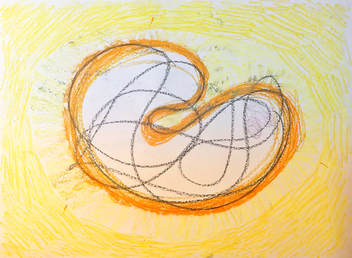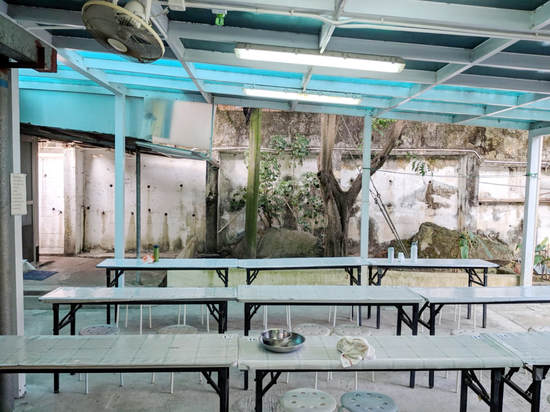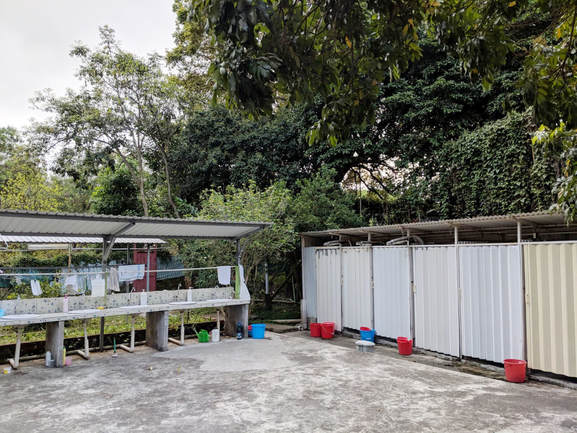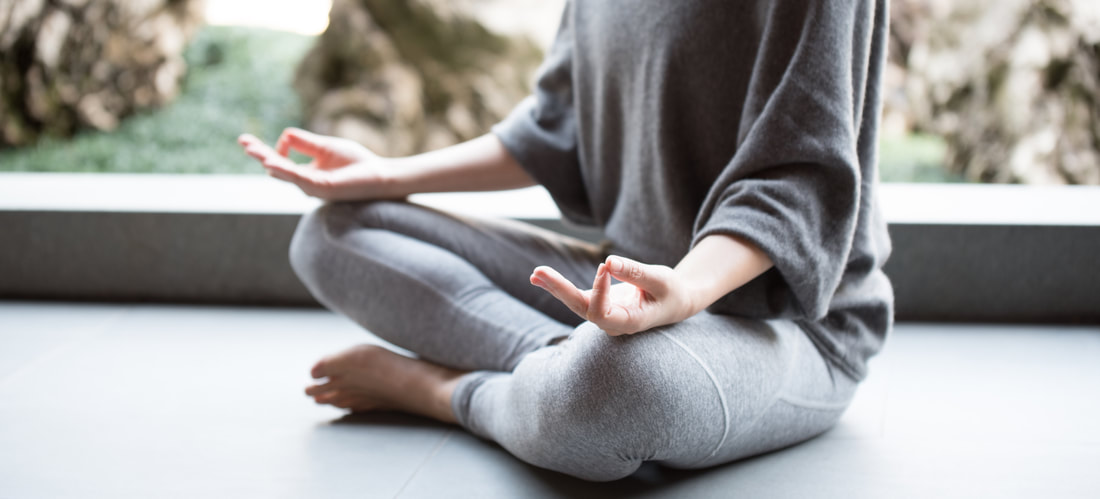 If sitting is not for you, I recommend to you active meditation. This summer, I spent two weeks at the Expressive Art Therapy Summer Institute at Prescott College, and experienced a form of active meditation. What is active meditation you may ask? Sitting meditation is turning inwards, and active meditations are about external reflections. They are both outlets for us to let go of what we don’t need, and tap into ourselves to find answers we seek. Many people have the misconception that meditation is only about sitting, and when they learn that they can’t sit, they refuse to practice. But in actuality, the state of meditation, or the “flow”, can be achieved through other means. And when we have a flow, the “noise” sinks, and we develop a full internal awareness to tap into our intuition. Expressive art therapy is not about the product, but the process. It is not about creating a beautiful piece of work you can display later on; the value is in the process of making it. Sharing your experience is optional, and no one will be taking pictures of your creation, so you can fully engage in the expression. And before you refuse expressive art, you should know that it is not just about art-art. It is inclusive of art, writing, poetry, and movement. Let me share with you a scribble drawing exercise I did. You have a choice of scribbling with your right hand with your eyes closed, or with your left hand with your eyes opened. I opted for scribbling with a pastel with my right hand, eyes closed. From start to stop, it all happened in less than one minute. After “pen’s down,” we got up and started looking at our scribble from different angles. Walking around what we just created, noticing any forms or shapes, interpreting what our scribbles could be. Just notice what you notice. Then we embellished what we wanted to stay, and covered what we don’t want/need. And we highlighted and decorated any parts that we desired. Lastly we wrote in our journals of our witness, thinking in terms of the art talking to you, and you just listening as you write. At this point, you probably think this sounds crazy: “A piece of drawing talking to me?” I know it is hard to imagine. You have to experience the process, non-judgmentally and with open acceptance, to understand it. It was not difficult at all to find meaning in my scribble. The experience amazed me in that I was able to access my intuition in such a simple and easy way. What occurred to me was I actually knew the message that came to me, just that my other I did not. The art that I created with my own hands helped deliver what my conscious-I needed to know. I also felt lighter after the experience, knowing that I can connect with myself. And very similarly I also get this clarity when I sit for meditation, usually for a longer period of time. I find active meditation a lot quicker in helping me get into the flow, and tapping into my instinct. FYI --- What you see from my art would totally be different from what I’ve derived from it because we bring with us years of preconception developed from our history, experiences, etc. Basically we all have a different blueprint. Meditation is turning inwards, and expressive art is external. No matter what form of practice we do, we have the answers. It’s just that in normal daily life, our world is full of distractions, which create a layer of noise that fogs up our thinking. So I tell you, if you can’t sit, it is not the end of the world. You can find your flow through other mindfulness practices! After my invigorating experiences with expressive art, I am eager to show you what active meditation is about. Join us on Sep. 29 as we introduce Active Meditation via Creative Expression!
2 Comments
4/3/2018 1 Comment as organic as it can getA 10-day retreat with no talking, writing, nor reading. Our phones were turned in during registration. Facilities were basic. Food was simple vegetarian. We did not have to make eye contact or even smile at anyone; we simply just went about as if we were there alone. We were limited to walking around only the designated areas. Men and women were in strict segregation. The morning bell rang at 4am and the lights were out at 9pm. The daily schedule consisted of alternating between meditating, eating and sleeping. I had the same preconception as you did reading these descriptions – apprehensive and doubtful, “Will I survive?” This was one of the most value-adding 10 days I have had in a long time. Time passed by much more quickly than I thought. Fast-forward to post-retreat, I feel grounded and renewed. We went back to our organic self (which was really living a simple life and having no technology) and the experience felt simply natural. A Thorough Unplug Felt Like a Reboot Until I experienced a thorough unplug myself, I did not realize how much I needed it. It sounded so unnatural simply because most of us have never done anything like that before – no communication and connection with the world, no obligatory small talks with the people around you, nothing to be done, and nowhere to go. Was I bored during those 10 days? Not even a second. The whole experience felt like a reboot, and now I am physically, mentally, and emotionally running so much more smoothly. It only worked because there was a deliberate attempt to eliminate all external distractions so the only focus was turned towards me, and only me. My Inner Compass Was Working When all you do is meditate and spend time with yourself, your inner compass will start working very well. There is only one voice, not 10 different distractions trying to get your attention. In one of the Dhamma talks, they described how we are already running towards death the moment we are born; every second and minute that pass, we are that much closer to the end of life. Then they moved on to talk about old-aged misery… Basically life is tough. Reflecting on that point, I wanted to test out my inner compass during my meditation. I asked myself two very abstract questions, “Then what is the purpose of all this [life]? Why are we all here?” In the snap of a finger, my epiphany arrived with a “ding!”. I was amazed at the speed and quality of my insight. I am not going to share here what the response was because that answer is unique for each individual, but what I want to illustrate is that our wisdom is within us – we just need to take the time to create the space to listen. The Goo Had an Outlet It was not all rainbows and unicorns during those 10 days. My fears came up. And in the beginning I did not even know – I thought they were just scary thoughts or flashbacks from my past that I randomly had. But I recognized the commonality of what came up – they were all the subconscious fears sitting at the back of my mind haunting me. The 10-day experience is compared to a surgery, where we go deep inside ourselves, we find the goo, and the practice (on the level of meditation and listening to the Dhamma talks) will eventually lead us to the road to recovery, so we can be well again. My fears were my “goo”. I had something to work on and that was why this experience was so productive. The clunks would not have “come out” (and would still be stuck) if I were not in that mental space. Technology is Much More Stressful Than I Thought I felt so light in those 10 days when I didn’t have my phone around me. It’s so hard to describe that subtle feeling. No whatsapp messages, no emails, nothing to keep checking. I felt I could breathe better, and it felt like I literally put 20lbs off my shoulders. One of the most interesting moments from the 10-day retreat was the moment when we were handed our phones back. When everyone started to turn them on and all the notifications from their phones started firing off, I had the most unexpected reaction. “Whoa, did you notice your body language?” was what my buddy said. “You just shuddered.” I felt a wave of stress kicking in as I also mentally prepared myself to turn on my phone. It’s not like I had work e-mails either. Whatever was in my inbox were all friendly messages, but even knowing that, I still had this unexplainable reaction of not wanting to go back to my phone. I wished we didn’t have to go back to our devices cause it felt so, so great to not have to live with any. Devices and communications are all actually optional. If I could live without knowing and responding to the 500+ whatsapp messages and the handful of emails I had during the 10 days, it probably wouldn’t matter if I ever did. We are giving way too much attention to our devices. I really should focus my time on things that matter more. Oh and during those 10 days I was able to lift my neck fully. What a feeling! Keep Learning How to Live Dhamma talks were what I looked forward to every day because they were like my school of life. “Equanimous” is my new favorite word. Equanimity is one of the teachings of “the art of living.” Practicing equanimity is when you experience unpleasant sensations, you don’t have to wish for it to stop, and when you are having a pleasant feeling, you don’t become attached to it. We always internally have this evaluation of what we like and what we don’t like, and this criticism is like a natural reflex – we always want anything “painful” or anything that’s not going our way to end as quickly as possible, and we hope for what we enjoy, whether it is “success,” “happiness,” or “highs”, to keep going and to get better. For example, you’ve got an apartment and now you want a car, and then you decide the apartment is not big enough, and you also start contemplating on a faster and more luxurious car. These are all first world problems – more, more, and more! But when it comes to pain, “just end right now!” As simple as the numbness in our legs during meditation, we wish so hard it would go away, and we just can’t wait for the session to end so we can free ourselves from the pain. In either scenario we are creating our own misery. Whether things are good or bad, it’s not here to stay forever. Just chill out. Everything is impermanent – they all rise, and they all fall… and then something new will come by. Stop creating your own misery. Life can just be life – no good or bad. Practice equanimity and observe the rise and fall. I am starting this practice. What Now?
The 10 days was not a dramatic, life-changing experience. It was literally like I took a refreshing shower (which I should do more often)! How the 10 days has impacted me will be something longer term, but to start with: I turned off all my phone notifications because there is no emergency in life. I am going to keep practicing equanimity. I am going to keep meditating as my daily self-maintenance routine, and schedule in an annual unplug. The clarity you can tap into when you declutter your mind (meditation), space (living in a distraction-free environment), and body (diet), was beyond what I had imagined. Other than that… I realize what we went through is ironically a luxury. How many people can tell their bosses they will not be responding to e-mails for the next 10 days? Probably not many. So blessed and grateful for this experience. 1/31/2018 3 Comments How to Start a Meditation PracticeWe don’t get ripped from going to the gym once, and it’s the same for meditation.
The benefits of meditation won’t happen just by thinking about it or wanting to do it. You HAVE to do it consistently. With physical exercise, you’re going to see a toned arm after regular arm workouts. With training your brain, you can’t see it physically, but you will feel the benefits. And it's pretty life-changing. So where to begin? A Resolve. You have to have an intention to do the practice. That means carving out a time to sit, and it’s best if you could make that time consistent so that you can create a habit and have a regular practice. People sometimes have a misconception that meditation takes a lot of time and think "I don't have time for it!" You don’t need to sit for an hour, even 5 or 10 minutes is better than none. AND everything is a matter of priority. “If you have time for social media, you have time for meditation.” A Place Find a place where you will be undisturbed, where no one will be asking for your attention. It’s okay if that place is not completely quiet. Sound is not a barrier to meditation. Just make sure to close the door and to let your family know that you need your quiet time. If you have pets, leave your pets outside. Some people also like to set up their meditation place like a sanctuary – lighting candles, having pictures of their loved ones…it’s all up to you. And if you want to have a mini unplug at work, another suggestion is to even find a meeting room. Again, make sure you'll be undisturbed. You might also want to look up meditation classes to go to. I find the experience of practicing in a group vs. solo is different. Explore What Resonates With You There are many types of meditation; you have to find what you like. Some people come to me and say “I can’t meditate” and then I ask them “What did you do?” Like exercising, just because you tried running and didn’t like it, you can’t say you’re not going to workout. You can also try yoga, circuit training, spinning, weights, dancing, etc. Touch, Sight, and Sound are three senses which most focused meditations are based on. Touch meditations can include breathing and body scans. Sight can be visionary (e.g. imagining a light) or candle gazing. Sound can be a mantra or singing bowls. YouTube or Apps (e.g. Headspace, Calm, Insight Timer) are good resources for you to find what you like! I highly recommend that when you are new to meditation, it is best to do guided meditations. This way there is a voice nudging back to the practice before you go too far in your thoughts and distractions. Now it's Up to You I have shared with you some pointers on how to kick-start your meditation practice. There is no secret to training your brain. It’s Time, Commitment, and Practice. Today is the last day of January. Last call for starting your 2018 goals! Sharing with you a quote, “The willingness to do creates the ability to do.” ~ Paul McWilliam |
|


